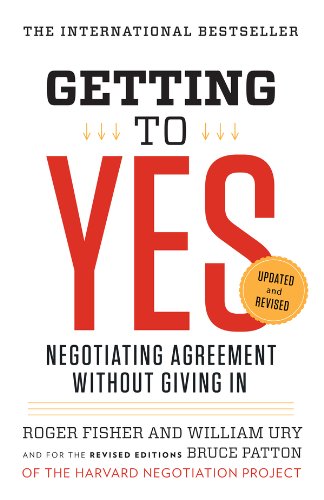

This article is an excerpt from the Shortform summary of "Getting to Yes" by Roger Fisher and William Ury. Shortform has the world's best summaries of books you should be reading.
Like this article? Sign up for a free trial here .
What is positional bargaining? And why should you avoid it?
Positional bargaining is a negotiation tactic in which each side defends its position and bargains to reach a compromise.
Learn why positional bargaining is an ineffective strategy and how to increase your chances of success in negotiations.
Problems With Positional Bargaining
There are three criteria for successful negotiation:
- The resulting agreement must be wise, meaning that it meets the interests of each side, and it’s fair and lasting.
- The process must be efficient, producing results without wasting time.
- The process must strengthen the relationship between the parties — or at least not damage it.
Positional bargaining falls short on all three counts.
What is Positional Bargaining?
In positional bargaining, each side starts with a position, argues and defends it, and bargains to reach a compromise. A classic example is when you haggle with a seller over the price of something.
Positional bargaining involves each side offering a series of positions and concessions, which takes considerable time. Each can clearly see what the other wants and the process usually leads to an agreement that both sides accept. But the agreement it produces doesn’t meet the three criteria (wise, efficient, and friendly).
Specifically, positional bargaining is problematic because:
1) Positional bargaining produces bad outcomes: Negotiators become rigid in their positions. The harder you try to convince the other side of the rightness of your position, and the more you defend it against attack, the more strongly committed to it you become. You feel compelled to maintain consistency with your past positions and to save face by not giving in.
For example, the 1961 U.S.-Soviet negotiations over a proposed nuclear test ban failed because of rigid positions on each side. Talks were bogged down over how many on-site inspections would be done annually — the Soviets wanted three and the U.S. ten. They got stuck there without having even defined the inspection procedure (for instance, how many inspectors could be sent into the other’s territory and for how long). An agreement on the inspection process might have addressed both sides’ desire for minimal intrusion and the U.S. interest in verification, while avoiding the arms race that ensued.
The greater the emphasis on positions, the less attention is paid to what each side really wants (the interests underlying their positions) and the less likely they are to reach a good agreement. Instead, the agreement will reflect a splitting of differences rather than addressing the valid interests of the parties. Both sides may end up dissatisfied and will have missed the opportunity for a good agreement.
2) Positional bargaining is inefficient: The give-and-take of standard negotiations, even when the parties aren’t hostile, is time-consuming. The process has built-in features that slow things down, such as starting with an unreasonable position and making incremental concessions. These common tactics work against a prompt settlement. Negotiation requires multiple individual decisions on offers, rejections, and concessions, each of which is an opportunity to stall. On top of that, negotiators can use deliberate delaying tactics and tricks such as threatening to walk out.
3) Positional bargaining undermines the ongoing relationship between the parties: When negotiations become a struggle of wills with each side trying to force its position on the other, anger and resentment build. The bad feelings can linger, hindering implementation and the ability of the two sides to work together in the future.
Positional bargaining works especially poorly for multilateral negotiations: When you have multiple sides in a negotiation, the inefficiency of the positional bargaining method is magnified.
For example, in United Nations talks where as many as 150 countries may be negotiating, all of them have to say “yes” for talks to proceed, but just one can stop the process by saying “no.” It’s hard to come up with a common position and even harder to change a position. Coalitions (East-West, North-South) tend to form around symbolic rather than substantive interests. Also, the various sides have to keep checking with higher authorities.
Sometimes negotiators try to mitigate the confrontational aspect of positional bargaining by being “nice,” that is, making overly lenient offers and concessions that don’t serve their interests in order to avoid conflict. They achieve an agreement, but not necessarily a good one. Being nice — prioritizing the relationship — is the approach most often used by family or friends. It’s especially risky if the other side plays hardball, in which case the nonaggressive bargainer is likely to lose his shirt.
The Solution: Principled Negotiation
You don’t have to engage in positional bargaining and choose either aggressive or soft bargaining along with their attendant problems. In contrast to the traditional adversarial approach, principled negotiation (which can also be called negotiating on the merits) is a much better way to arrive at wise agreements in an efficient way.
Principled negotiation can be used in almost any circumstances and it’s straightforward: the two sides work toward agreed-upon mutual interests rather than having hidden agendas.
There are four components to principled negotiation:
- People: Separate personalities and emotions from the issue being negotiated.
- Interests: Focus on the interests of each side — the reasons underlying their positions — rather than on positions.
- Options: Come up with multiple options based on mutual interests.
- Criteria: Base the agreement on an objective (fair and independent) standard.
By focusing on the interests of each side — what each side wants — rather than on each side’s position — their preferred solutions — you avoid the pitfalls of positional bargaining and more easily move past barriers to negotiation.
———End of Preview———

Like what you just read? Read the rest of the world's best summary of "Getting to Yes" at Shortform . Learn the book's critical concepts in 20 minutes or less .
Here's what you'll find in our full Getting to yes summary :
- Why the standard way of negotiating is completely wrong
- How to find outcomes that are wins for both sides
- How to protect yourself against aggressive negotiators






